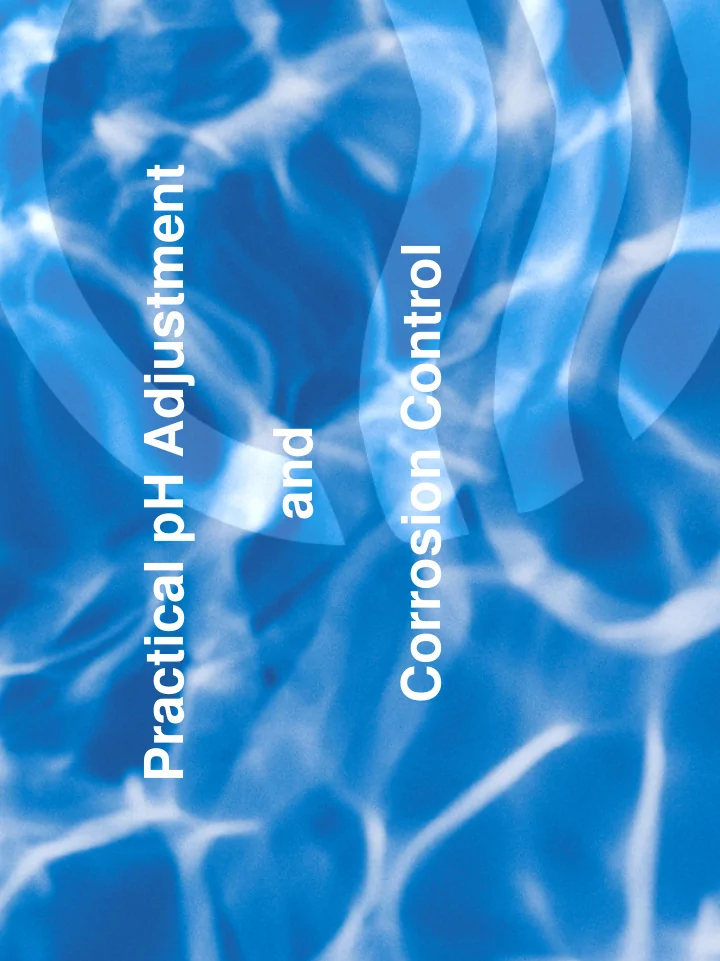

Practical pH Adjustment Corrosion Control and
Why is this important to me? • Acid water dissolves concrete pipe and concrete cisterns • Acid water makes red water fast on contact with cast iron or ductile iron pipe
What Causes Acid Water? • Rain picks up carbon dioxide… pH can go down to 5 due to carbonic acid (weak) • Any industrial sulfur or nitrogen acids ….pH down to 4 because of sulfuric and nitric acids • Decaying vegetation…. microbe makes organic acids which are very weak… humic and fulvic acids. These acids are weak but can carry metals • Absence of limestone or dolomite to neutralize and buffer the water • Use of an acidic treatment chemical like alum
If You Can’t Measure it you don’t know when you are about to arrive in trouble and…… You’ll be guessing when you try to fix it.
How to measure acidity There are two factors pH and buffering • A little of a strong acid delivers sharpness/punch/intensity. Drops pH instantly a long way but is easily and cleanly reversed by alkalis. • A weak acid gradually reduces pH by much less …low punch/intensity but its effect is harder to correct. Shock Absorber = buffer action • Harder water resists effects due to a natural buffer
Here is what you need
How does the meter/electrode work? • The meter is a low voltage voltmeter that measures while hardly taking any current from the sensor. (high impedance) • The electrode is a small single cell battery that uses water for the internal liquid. • The electrode has internal fluids and glass in contact with the water – very easily fouled/blocked • At pH 7 the electrode gives 0.000 volts • Stir • Help the water conduct with KCl
Maintenance • Recalibrate every day – throw the pH 7 calibration buffer often • Electrodes fouled – slow response in the water (faster in calibration buffer – check with 100x diluted buffer – settles at pH 7 in <10 seconds) • Clean only when necessary with electrode cleaner • Electrode storage solution MUST be used • Have a spare electrode ready • Consider buying a battery powered electrode simulator (this is a voltage generator)
Buffer/shock absorber measurement
Buffer/shock absorber measurement • Add acid from the titrator in stages • don’t use the indicator method • Track pH – find how much alkalinity you have over pH 7 (under 7 is irrelevant) • Look for how fast the pH comes down toward 7 • Add a little soda ash and check again
Why is this Important? • Water stability – pH changes are resisted • At pH 7 or over the water wont strip oxides from metals • With carbonate and CO2 in it concrete is protected by a carbonate film • Exposed metal gets a carbonate film
Causes of corrosion • Metals are mostly unstable • Oxidation is the process to stability • Corrosion slowed by natural oxide or carbonate layer (or anything else like paint) • Acids remove oxides and carbonates • Microbes especially iron bacteria promote corrosion • (Zinc kills microbes and dissolves first)
Weak Electrical Process • One part of metal goes electrically negative another positive – one gets alkaline the other acidic – the less buffer the easier for the pH to change. • Not 110 volts….0.2 to 2 volts driving force • Stray voltages can drive • Currents high, volts low • Dump electrons • Different metals – set up electrical battery
Adding a strong alkali Put the pH up to 9+ with caustic soda • Requires flow paced addition with a dangerous freezable liquid • High pH 9 plus stops corrosion of iron – overwhelms acid • More THMs get formed much faster • Water acquires a bitter taste • Danger in dead ends of coliforms • Always works but costly and may require use of ammonia
Compromise 1 Put the pH up to 7.2 to 7.5 at plant with soda ash • Needs flow paced addition from a 5% solution • Good buffer • Retains chlorine bactericide power • Does not accelerate THMs formation • Modest cost but does not always work
Compromise 2 • Up to 10 ppm at plant with sodium silicate • Needs flow paced addition from a 5% solution up to 10 ppm silica (no scum on your coffee) • Adds a little buffer action • Gums the rust onto the pipe • Retains chlorine bactericide power • Does not accelerate THMs formation • Inexpensive but does not always work
Compromise 3 • Add caustic soda (Sodium Hydroxide) to pH 8 • Needs flow paced addition from a 50% freezable solution • Adds very little buffer action • Retains chlorine bactericide power • Accelerates THMs formation • Inexpensive relative to soda ash but often does not work
Compromise 4 • Add “ whiffle dust” (phosphate/polyphosphate inhibitor) • Needs flow paced liquid addition • Adds a little buffer action • Retains chlorine bactericide power • Feeds biofilm bacteria • expensive relative to soda ash but usually works well at first then fails and requires extra bleeders
Use natures’ solution the limestone chip contactor • Tank filled with 1 inch nominal chips (imports?) • Upflow of water – chips dissolve create hardness/alkalinity • Only suitable for smaller plants • Fines are a periodic problem – rapid flush needed • Can put the pH up too high for chlorine activity – needs a local pilot • Tank distortion
How to deal with corrosion • Keep microbes quiet with a good chlorine residual • Track pH in distribution and alkalinity and pH over 7 at the plant through seasons and storms • Avoid using metal pipes • Use an alkaline buffer and/or “gummy” silicate or a limestone contactor whatever works • Remove anything that can carry electrons away from the metal eg oxygen or chlorine – well water • Add “whiffle dust” • Think about how to measure effectiveness Tony Edmonds 2006/02/16 tedmondst@ocwa.com
Recommend
More recommend